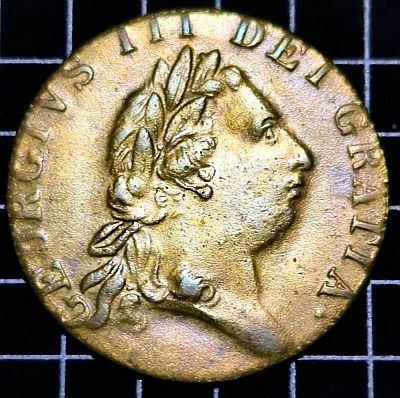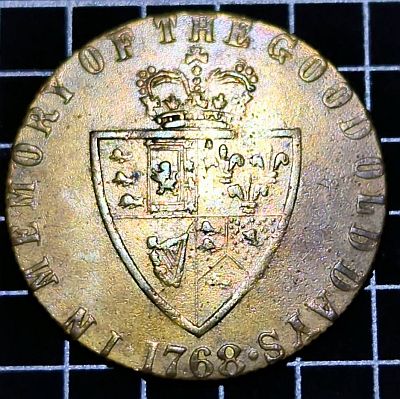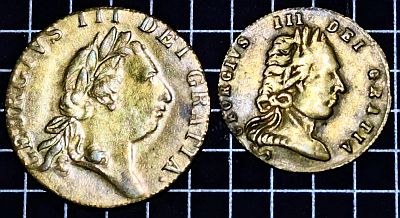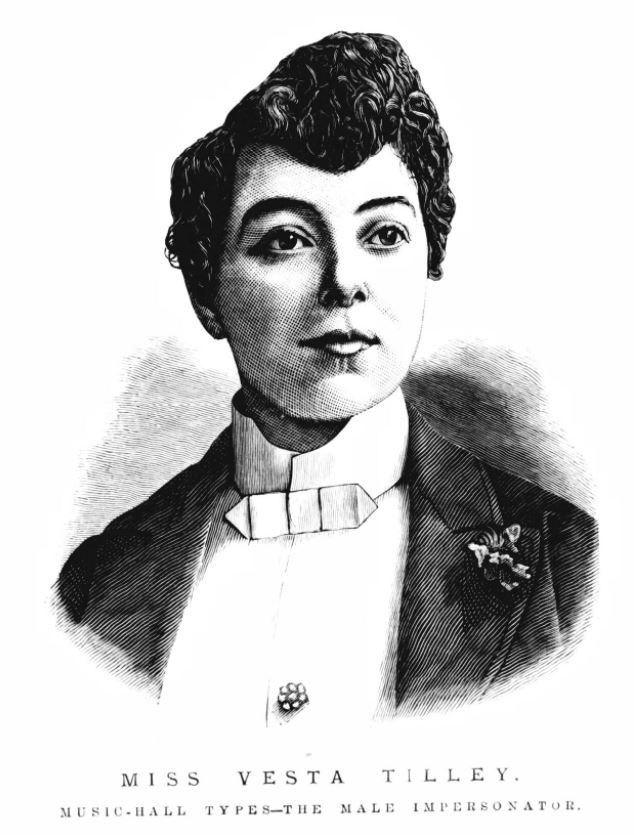One of many fascinating gaming tokens
Gaming tokens
George III became king of the United Kingdom in 1760, following the death of his grandfather, George II. The industrial revolution was just getting under way, and local manufacturers were in a position to produce commemorative medalets. These were made firstly to mark his ascension, and then his marriage the following year. These in turn, gave way to gaming counters modelled on his gold coinage. Early pieces often imitated the coinage of Queen Anne (Queen of England, Scotland & Ireland 1702-1707 and Queen of the United Kingdom 1707-1714).
The gold Guinea had been introduced in Britain in 1663 and was one of the first coins to be milled rather than hammered. In 1787, the design of the shield on the coin changed to a “spade” shape. Like a down-facing triangle with the two lower sides curved – like a garden spade – and this is why they came to be called “Spade-Guineas“. The spade-shaped shield on the Guinea was replaced with a round design in the early 1800s, and the Guinea itself was replaced by the sovereign in the Great recoinage of 1816.
The first brass tokens made in the likeness of the spade guinea were made less than a year later, in 1788. These were popular as “gaming counters” for gambling with, and to a lesser extent were also used as props in the theatre.
In the 1860s, laws around producing imitation coins started to be enforced more strictly. In 1883, the “Counterfeit Medal Act” was passed, essentially ending the practise. In the 1860s, gaming tokens resembling the earlier spade-guineas became popular again. A design which clearly did not reflect actual coinage, but which was familiar. Rather than directly copying the earlier coin exactly, these pieces often featured phrases such as “In Memory of the Good Old Days”.
Obverse

The obverse features George III facing right, with the text “Georgivs III Dei Gratia” (George III, by the Grace of God).
One interesting aspect about these tokens is that there are so many variants. The key reference for these is “A Thousand Guineas Plus. A Checklist of Imitation Guineas and their Fractions” by W. Bryce Neilson and Martin R. Warburton, published by Galata. As the name implies, the book lists over a thousand variants of these tokens. I was fortunate to correspond with author Martin R. Warburton. This particular coin came from him, and I am honoured to be able to share it with you. This is listed as #4970 in the book, and is described as “Stop 2mm from bust, right hand leaf to before D, lowest ribbon tail touches G, upright of G’s missing left-hand serif.” Actually, this is listed as “Same dies as last, normal flan (ca 3.5g), grained edge”, with the last, #4960 listed as “Obverse: Same die as last”. The “stop” refers to the full stop after “Gratia”. The leaf refers to the three leaves in the laurel wreath the King is wearing, there are usually three leaves which stick up above his hair.
Reverse

The reverse has the crowned spade-shaped shield with “In memory of the good old days” around the edge and the date 1768. We know that this was not made in that year but more likely a century later. The description for the reverse is “Top of crown to left of H, top-right of shield lines to D, fleurs-de-lis each in 5 distinct parts”
Comparison
It is often easier to compare differences when you have two examples. Here are two different versions of “In memory of the good old times” tokens:

The right piece is clearly smaller – an imitation spade half-guinea rather than guinea. It is #4620 in “A Thousand Guineas Plus”. This is described as “No Stop, A 1.5mm from bust, left-hand leaf to left tip of third I, back of head straight, horizontal row of 4 open curls just above truncation.” The shape of the head and neck, position and shape of the letters and details such the lack of a stop after Gratia, and where the leaves of the laurel are pointing would help identify pieces. The orientation and edge style of pieces is also noted (in this case, both are medal alignment and reeded.
This particular half guinea imitation also has the note in the book: “Example known with Vesta Tilley 2 9 12″ hand inscribed on reverse”. Vesta Tilley performed from 1869 – 1920.

Image of Miss Vesta Tilley, male impersonator, from 1887, image from BritishNewsPaperArchive.
Examples of this particular Imitation Spade Guinea were likely used in a show, perhaps in September 1912.

Interesting here is another image of Vesta Tilley, with an “Ogden’s Guinea Gold Cigarettes” ad. From the National Portrait Gallery. Perhaps this tied in with her use of imitation gold guineas in her performance?


Leave a Reply